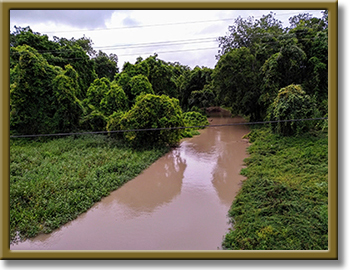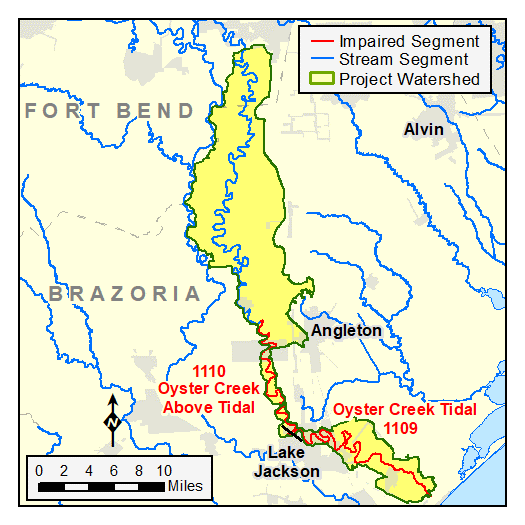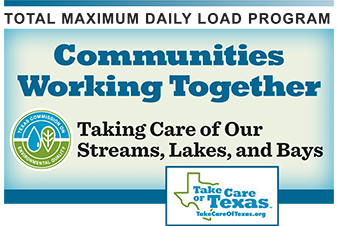Oyster Creek: Bacteria

Photo Courtesy of the
Houston-Galveston Area Council
Counties: Brazoria, Fort Bend
Parameter: Bacteria
Basin: San Jacinto–Brazos Coastal
Segments: 1109, 1110
Assessment Units (AUs): 1109_01, 1110_01
On this page:
- Background and Goals
- Watershed Description
- Get Involved
- Approved I-Plan
- Adopted TMDLs
- Reports
- For More Information
Background and Goals
Since 2006, high concentrations of bacteria, which are found in both human and animal waste, have been observed in two segments of the creek—Oyster Creek Tidal (1109) and Oyster Creek Above Tidal (1110). Oyster Creek Tidal has only one AU, 1109_01. The Above Tidal segment has three AUs; only the lower AU, 1110_01, is impaired for bacteria. The presence of these bacteria may indicate a health risk to people who swim or wade in the creek—activities referred to as “contact recreation” in the Texas Surface Water Quality Standards.
To address these concerns, people who have a stake in the watershed are working with TCEQ to develop TMDLs and an I-Plan. A TMDL is like a budget—it determines the amount (or load) of bacteria the creek can receive and still support the contact recreation use. The allowable load is then allocated among categories of sources within the watershed. The I-Plan outlines the measures that will be used to reduce pollution.
The goal of this project is to improve water quality to protect recreational uses.
Watershed Description
The Oyster Creek watershed lies in southeast Texas within the Houston Area. The 95-mile creek originates in southeastern Fort Bend County and travels southward through central Brazoria County before turning southeastward at the city of Lake Jackson. From there, Oyster Creek meanders and broadens across the Texas coastal plain before terminating at the Gulf Coast Intracoastal Waterway (ICWW) near the cities of Brazosport and Surfside Beach. The watershed includes portions of Fort Bend and Brazoria counties.
Oyster Creek Above Tidal (Segment 1110) has had significant hydrologic modifications. The northern potions of Oyster Creek near Interstate 69 in the city of Sugarland were cut off from the remaining portion by a diversion dam 1.1 mile upstream of State Highway 6. This diversion allowed for the ponding of irrigation water pumped from the Brazos River to support sugar production. The waters are now being used as amenity lakes for commercial and residential purposes. A separate diversion canal was completed in 1998 to prevent the flooding of the Sienna Plantation subdivision.
The Oyster Creek Above Tidal segment is approximately 70 miles in length and travels mostly south from Missouri City until it reaches the city of Lake Jackson. Oyster Creek Above Tidal has three assessment units (AUs) Only the lower AU, 1110_01, is impaired for bacteria.
The Oyster Creek Tidal segment (1109) begins northwest of the city of Lake Jackson in Brazoria County and flows 25 miles southeastward to its confluence with the ICWW. There is only one AU for the segment, 1109_01, or the entire segment. The tidal segment has a watershed area of 29 square miles.
Agriculture and petrochemical production are the primary economic drivers in and near the watershed. Most of the population can be found in the upper portion of the watershed.
Get Involved
Staff from the Houston–Galveston Area Council (H-GAC) have been working with communities, interest groups, and local organizations to distribute information about this project and involve stakeholders in developing the I-Plan for watershed improvement. All public meetings about this project are open to anyone interested. Watch for meeting announcements here. See meeting records in the "Get Involved" section of the H-GAC's webpage San Jacinto-Brazos Coastal Basin Bacteria Reduction Project .
Approved I-Plan
Community stakeholders worked together to create the I-Plan. The Commission approved the stakeholders' plan on July 9, 2025.
- I-Plan for Two TMDLs for Indicator Bacteria in the Oyster Creek Watershed
- Response to public comment (no comments received)
Adopted TMDL
The Commission adopted these TMDLs on Aug. 14, 2024. EPA approved them on Sept. 26, 2024, at which time they became an update to the state's Water Quality Management Plan.
- Two TMDLs for Indicator Bacteria in the Oyster Creek Watershed
- Response to Public Comments on the TMDLs for Oyster creek Watershed (no comments received)
- Response to Preliminary EPA comment (no comments received)
Reports
For More Information
Please email tmdl@tceq.texas.gov, and mention the Oyster Creek bacteria project in the subject line. Or call us at 512-239-6682.





 Back to top
Back to top